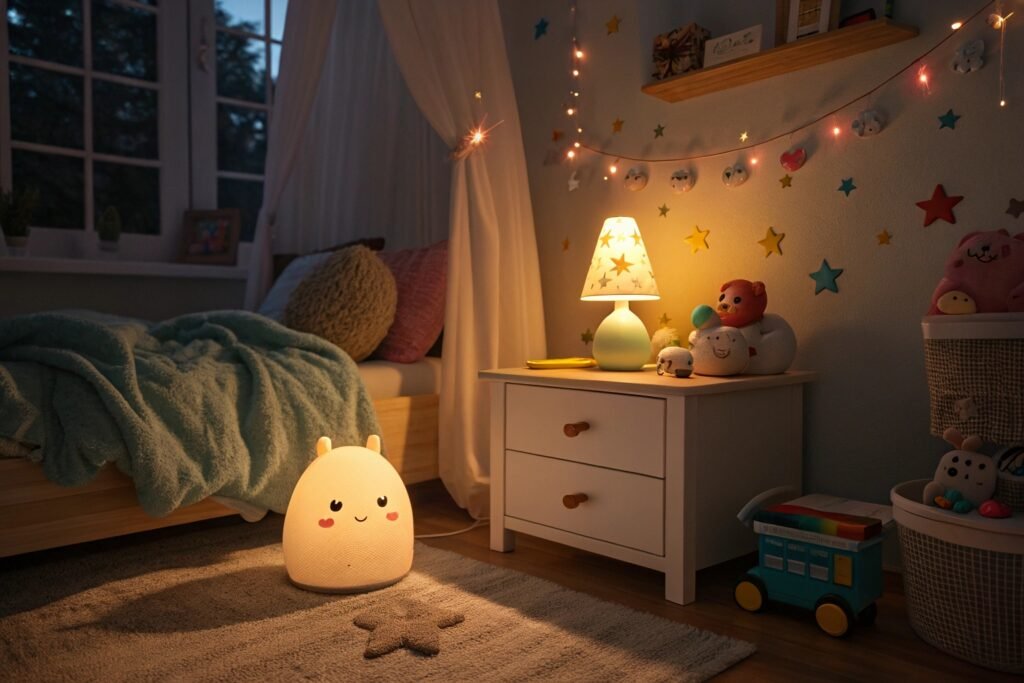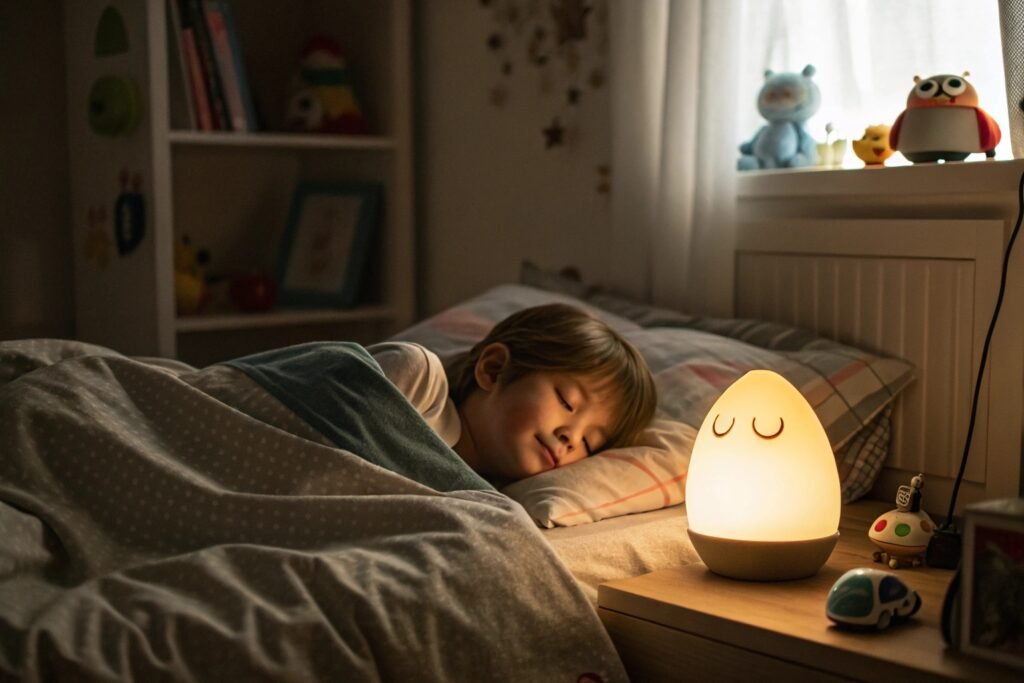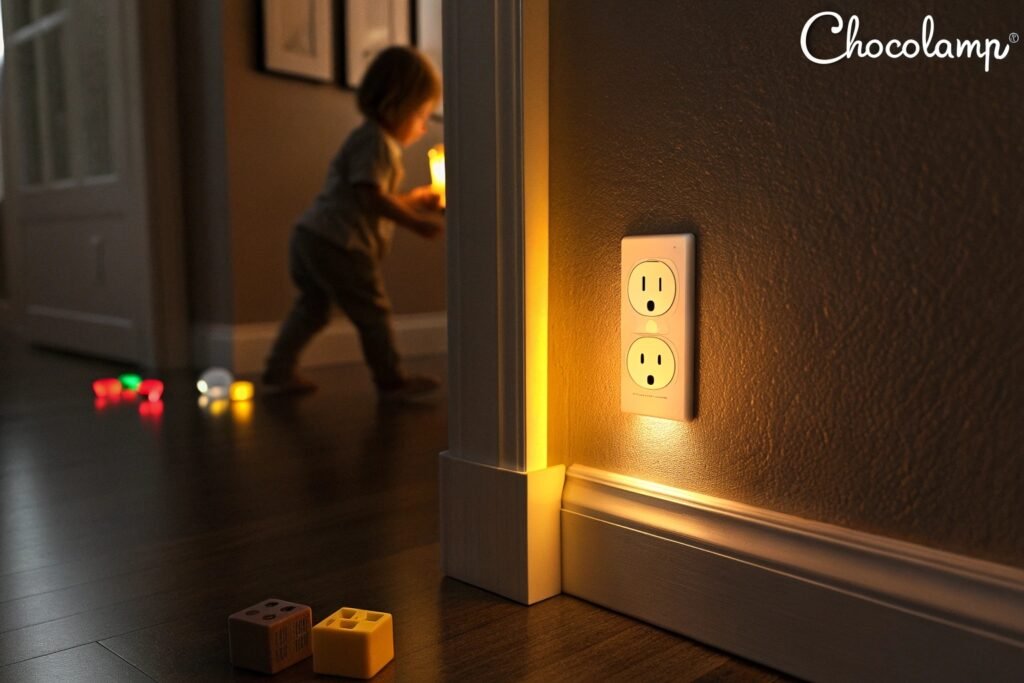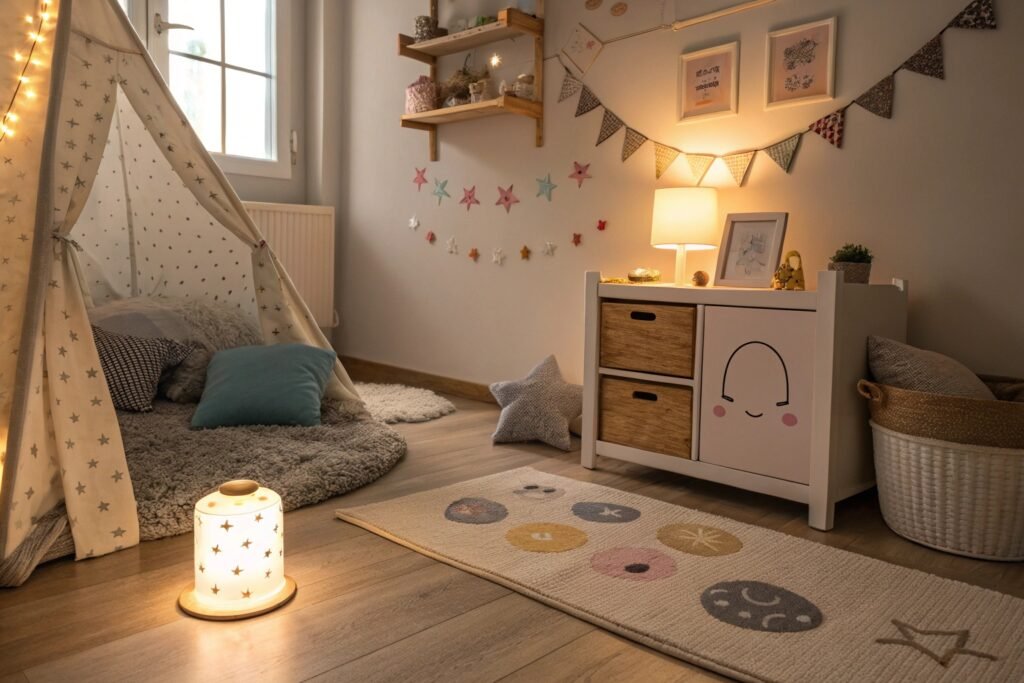Pssst—worried that night lights might harm your kids? I get it, I’ve been there too. Let’s figure out if they’re really a problem or a hidden gem for sleep.
Good news—I’ve found night lights can help kids! Used right, they ease fears and boost safety. Go for dim, warm tones (2700K-3000K) to avoid sleep issues.
 Dim Night Light
Dim Night Light
I’ve dug into this because I care about kids’ sleep—mine included! Stick with me to learn how night lights can work wonders when used smartly.
Is It Okay for Kids to Have a Night Light?
Picture this: your kid wakes up scared of the dark—heart racing, tears flowing. I’ve seen it with my own little ones. So, are night lights safe?
Yes, kids can use night lights! Dim, warm ones (2700K-3000K) feel safe without ruining sleep. Bright lights, though, can mess things up—choose wisely!
 Kid Sleeping Peacefully
Kid Sleeping Peacefully
I’ve learned a lot as a parent and from research. Let’s break it down to see why night lights can be a game-changer for kids.
Why Night Lights Can Work
Night lights aren’t just random gadgets—they’ve got real perks when done right. I’ve tested this myself and heard from other parents too. Here’s what I found.
- Fear Buster: A soft glow makes the dark less scary. My kid used to call out for me—now they sleep better.
- Safety First: Kids can see where they’re going at night. No more bumps or falls—it’s a relief!
- Special Needs Help: For kids with autism, a steady light feels calming. A friend’s child sleeps sounder now.
Here’s a quick table to show it clearly:
| Benefit | How It Helps |
|---|---|
| Fear Buster | Cuts down dark-related anxiety |
| Safety First | Stops trips and falls at night |
| Special Needs Help | Gives comfort to kids who need routine |
I’ve seen how a faint light can turn a tough night into a peaceful one. It’s not just about sleep—it’s about feeling secure.
What Are the Active Effects of Night Lights?
Ever wonder why some kids sleep like angels with a night light on? I’ve noticed it with my own kids. Let’s look at the good stuff they bring.
Night lights cut fear, help kids move safely, and comfort special needs kids. Dim, warm light (2700K) keeps sleep on track while feeling cozy.
 Cozy Night Light Glow
Cozy Night Light Glow
There’s more to it than just a pretty glow. I’ve got stories and facts to share about how night lights shine bright in the best ways.
The Upside of a Little Light
Night lights can do wonders—I’ve seen it firsthand. They’re not just for looks; they solve real problems. Here’s what I’ve picked up.
- Fear Goes Away: My kid used to hate bedtime. A soft light changed that fast—they drift off easier now.
- Nighttime Explorer: Kids can get up for water without crashing. I love knowing they’re safe on their own.
- Comfort Zone: A customer told me their autistic child sleeps through the night now. That’s huge!
Check this table for a clear view:
| Positive Effect | What It Does |
|---|---|
| Fear Goes Away | Makes bedtime less scary |
| Nighttime Explorer | Helps kids move without accidents |
| Comfort Zone | Calms kids who need steady light |
I’ve watched my kids go from restless to relaxed with the right light. It’s a small fix with big wins.
What Are the Negative Effects of Night Lights?
Okay, night lights aren’t perfect—sometimes they cause trouble. I’ve had moments where I wondered if I picked the wrong one. What’s the downside?
Bright or blue lights can mess up sleep by blocking melatonin. Kids might rely on them too much or play instead of resting.
 Bright Night Light Warning
Bright Night Light Warning
I’ve made mistakes with night lights before. Let’s dive into what can go wrong so you can avoid my slip-ups.
When Night Lights Backfire
Not every night light is a hero—I’ve learned that the hard way. Too much light can flip the script. Here’s what I’ve seen.
- Sleep Trouble: Bright lights keep kids awake. I swapped a blue one out after restless nights.
- Too Attached: Some kids won’t sleep without it. My friend’s kid struggled when it broke.
- Playtime Risk: A strong glow tempted my kid to read late. Bedtime got messy fast.
Here’s a breakdown:
| Negative Effect | What Happens |
|---|---|
| Sleep Trouble | Bright light stops melatonin, delays sleep |
| Too Attached | Kids can’t sleep without it |
| Playtime Risk | Light invites late-night fun |
I’ve had to tweak things when a night light went wrong. It’s all about finding balance.
How to Use a Night Light Correctly?
Frustrated picking the right night light? I’ve been there—trial and error taught me a lot. How do you make it work?
Pick dim, warm lights (2700K-3000K), place them low, and adjust as needed. Watch sleep patterns to keep things smooth.
 Perfect Night Light Setup
Perfect Night Light Setup
I’ve got tips that worked for me and my customers. Let’s go deeper into making night lights a win for your kids.
Getting It Right
Using a night light isn’t rocket science, but it takes care. I’ve fine-tuned my approach over time. Here’s what I suggest.
- Light Choice: Go for dim, warm tones. I use 2700K—it’s soft and sleep-friendly.
- Smart Spot: Keep it low, not in their eyes. I put mine near the floor—works great.
- Check Sleep: If they’re restless, tweak it. I dimmed ours when my kid woke too early.
Here’s a handy table:
| Tip | How to Do It |
|---|---|
| Light Choice | Use dim, warm light (2700K-3000K) |
| Smart Spot | Place it low, away from eyes |
| Check Sleep | Adjust if sleep changes |
I’ve helped parents find the sweet spot with night lights. It’s simple once you know the tricks.
Conclusion
Night lights are great for kids if used right. They ease fears and boost safety—just keep them dim and warm.
About My Business
I’m Lily Chen, founder of Chocolamp in China. We make night lights and lamps for wholesalers. Email me at sales@chocolamp.com or visit www.chocolamp.com!


